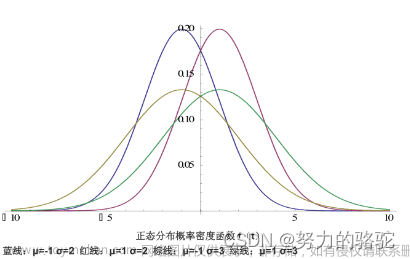目录
基本概念
概率密度函数(PDF: Probability Density Function)
累积分布函数(CDF: Cumulative Distribution Function)
核密度估计((kernel density estimation)
1.正态分布
概率密度函数(pdf)
正态分布累积分布函数(CDF)
正态分布核密度估计(kde)
正态分布四则运算
二维正态分布(逐渐补充)
马氏距离
2.卡方分布
概率密度函数(pdf):
卡方分布表:
卡方分布相关计算
生成卡方分布随机数
3.学生t分布
概率密度函数(pdf):
基本概念
概率密度函数(PDF: Probability Density Function)
连续随机变量的概率分布特性。
累积分布函数(CDF: Cumulative Distribution Function)
在x点左侧事件发生的总和。
CDF特性:
①因为累计分布函数是计算x点左侧的点的数量,所以累计分布函数CDF是单调递增的。
②所有的CDF中,在x趋近-∞时,CDF趋近于0,当x趋近+∞时,CDF趋近于1。
③对于给定的数据集,CDF是唯一的
核密度估计((kernel density estimation)
核密度估计(kernel density estimation,KDE)是在概率论中用来估计未知的密度函数,属于非参数检验方法之一,通过核密度估计图可以比较直观的看出数据样本本身的分布特征。
scipy中的stats.gaussian_kde可以计算高斯核函数的密度函数,而且提供了直接计算区间的累计密度函数,integrate_box_1d(low=-np.Inf, high=x)。
1.正态分布
表示为:,其中期望为μ,方差为。
概率密度函数(pdf)
python画图效果及代码(包含随机数生成):

import numpy as np
import matplotlib.pyplot as plt
import matplotlib.mlab as mlab
import matplotlib.cm as cm
import math
import scipy.stats as stats
plt.rcParams['font.sans-serif'] = ['SimHei'] # 用来正常显示中文标签
plt.rcParams['axes.unicode_minus'] = False # 用来正常显示负号
################################ 正态分布 ###########################
# 根据均值、标准差,求指定范围的正态分布概率值
def normfun(x, mu, sigma):
pdf = np.exp(-((x - mu)**2)/(2*sigma**2)) / (sigma * np.sqrt(2*np.pi))
return pdf
np.random.seed(0) ## 定义一个随机数种子
result = np.random.normal(loc=10, scale=16, size=1000) # 均值为10,标准差为16
## !!!强调,以上参数中scale为标准差(方差的根号),不是方差,
# 设定 x,y 轴,载入刚才的正态分布函数
x = np.arange(min(result), max(result), 0.1)
y = normfun(x, result.mean(), result.std())
plt.plot(x, y) # 这里画出理论的正态分布概率曲线
plt.hist(result, bins=20, rwidth=0.8, density=True) ## 柱状图
plt.title('distribution')
plt.xlabel('temperature')
plt.ylabel('probability')
plt.show()正态分布累积分布函数(CDF)

################################ 累积分布函数cdf ###########################
#计算正态概率密度函数在x处的值
def norm_dist_prob(theta):
y = stats.norm.pdf(theta, loc=np.mean(data), scale=np.std(data))
return y
#计算正态分布累积概率值
def norm_dist_cdf(theta):
y = stats.norm.cdf(theta,loc=np.mean(data), scale=np.std(data))
return y
## 数据生成
data = np.random.normal(loc=0.0, scale=10, size=1000)
x = np.linspace(stats.norm.ppf(0.01,loc=np.mean(data), scale=np.std(data)),
stats.norm.ppf(0.99,loc=np.mean(data), scale=np.std(data)), len(data)) #linspace() 函数返回指定间隔内均匀间隔数字的 ndarray。
y1=norm_dist_prob(x)
y2=norm_dist_cdf(x)
plt.plot(x, y1,'g', label='pdf')
plt.plot(x, y2,'r', label='cdf1')
#或
sns.kdeplot(data,cumulative=True, label='cdf2')
plt.legend()正态分布核密度估计(kde)
################################ 核密度估计 ###########################
## 数据生成
data = np.random.normal(loc=0.0, scale=10, size=1000)
## 本程序是根据数据进行概率密度估计
density = stats.gaussian_kde(data) #, bw_method=None, weights=[i[4] for i in data1]
density.covariance_factor = lambda : .25 # lambda : .25
density._compute_covariance()
density.set_bandwidth(bw_method='silverman') ## 调用set_bandwidth 后计算的新带宽用于估计密度的后续评估。可选‘scott’, ‘silverman’
xs = np.linspace(min(data), max(data), 200)
fig, ax = plt.subplots()
ax.plot(xs, density(xs), 'r')
ax.fill_between(xs, density(xs), color="r", alpha=0.1)
ax.hist(data, bins=30, rwidth=0.96, density =True, alpha=0.6,color = 'steelblue', edgecolor = 'w', label = 'dimensional histogram statistic ')
## 或者用seaborn
fig, ax = plt.subplots()
sns.distplot(data, hist=True, kde=True, rug=True, bins=20, ax=ax)
# 通过hist和kde参数调节是否显示直方图及核密度估计(默认hist,kde均为True)
# bins:int或list,控制直方图的划分
# rug:控制是否生成观测数值的小细条
# ax = sns.distplot(x, rug=True, rug_kws={"color": "g"},
# ... kde_kws={"color": "k", "lw": 3, "label": "KDE"},
# ... hist_kws={"histtype": "step", "linewidth": 3,
# ... "alpha": 1, "color": "g"})fig, ax = plt.subplots()正态分布四则运算
两个相互独立的正态分布分别满足
则:
二维正态分布(逐渐补充)
其生成及协方差椭圆的python实现如下:

################################ 二维正态分布 ###########################
from matplotlib.patches import Ellipse
def get_error_ellipse_parameters(cov, confidence=None, sigma=None):
"""Returns parameters of an ellipse which contains a specified
amount of normally-distributed 2D data, where the data is
characterised by its covariance matrix.
Parameters
----------
cov : array_like
Input covariance matrix of shape (2,2)
confidence : float
Fraction of data points within ellipse. 0 < confidence < 1.
If confidence is not given, it is calculated according to sigma.
sigma : float
Length of axes of the ellipse in standard deviations. If
confidence is also given, sigma is ignored.
Returns
-------
semi_major : float
Length of major semiaxis of ellipse.
semi_minor : float
Length of minor semiaxis of ellipse.
angle : float
Rotation angle of ellipse in radian.
confidence : float
Fraction of data expected to lie within the ellipse.
sigma : float
Length of major and minor semiaxes in standard deviations.
"""
cov = np.array(cov)
if(cov.shape != (2,2)):
raise ValueError("The covariance matrix needs to be of shape (2,2)")
if(confidence == None and sigma == None):
raise RuntimeError("One of confidence and sigma is needed as input argument")
if(confidence and sigma):
print("Argument sigma is ignored as confidence is also provided!")
if(confidence == None):
if(sigma < 0):
raise ValueError("Sigma needs to be positive")
#scaling = np.square(sigma)
scaling = sigma
confidence = stats.chi2.cdf(scaling, 2)
if(sigma == None):
if(confidence > 1 or confidence < 0):
raise ValueError("Ensure that confidence lies between 0 and 1")
scaling = stats.chi2.ppf(confidence, 2)
#sigma = np.sqrt(scaling)
sigma = scaling
eigenvalues, eigenvectors = np.linalg.eig(cov)
maxindex = np.argmax(eigenvalues)
vx, vy = eigenvectors[:, maxindex]
angle = np.arctan2(vy, vx)
semi_minor, semi_major = np.sqrt(np.sort(eigenvalues) * scaling)
print("With sigma = {:.3f}, {:.1f}% of data points lie within ellipse.".format(sigma, confidence * 100))
return semi_major, semi_minor, angle, confidence, sigma
mu = [1,2]
cov = [[50,30],[30,50]] #sigma
# 随机数生成
z = stats.multivariate_normal(mu, cov)
data_points = z.rvs(size = 5000)
fig, ax = plt.subplots()
plt.scatter(data_points[:,0], data_points[:,1], alpha = .5)
# 画置信度椭圆
confidence = 0.95
semi_major, semi_minor, angle, confidence, sigma = get_error_ellipse_parameters(cov, confidence = confidence)
ax.add_patch(Ellipse(mu, 2*semi_major, 2*semi_minor, 180*angle/np.pi, facecolor = 'none', edgecolor = 'red', label = 'Confidence = {:.0f}% (sigma = {:.2f})'.format(confidence * 100, sigma)))
sigma = 1
semi_major, semi_minor, angle, confidence, sigma, = get_error_ellipse_parameters(cov, sigma = sigma)
ax.add_patch(Ellipse(mu, 2*semi_major, 2*semi_minor, 180*angle/np.pi, facecolor = 'none', edgecolor = 'yellow', label = 'Sigma = {:.0f} (confidence = {:.1f}%)'.format(sigma, confidence * 100)))
plt.legend()
plt.show()马氏距离
计算马氏距离(Mahalanobis Distance)。一维马氏距离定义为:
iv = [[1, 0.5, 0.5], [0.5, 1, 0.5], [0.5, 0.5, 1]]
md = distance.mahalanobis([1, 0, 0], [0, 1, 0], iv)
print(md)
# 或
p = np.array([1,1])
distr = np.array([2,2])
cov = [[1,0.2],
[0.2,1]]
dis = distance.mahalanobis(p, distr, cov)
# p: 一个点
# distr : 一个分布
# 计算分布的协方差矩阵
#cov = np.cov(distr, rowvar=False)
# 选取分布中各维度均值所在点
#avg_distri = np.average(distr, axis=0)
print(dis)2.卡方分布
卡方分布,也写作:分布。服从自由度为n的卡方分布,记作,其均值为 n,方差为2n。
若n个相互独立的随机变量ξ₁,ξ₂,...,ξn ,均服从标准正态分布N(0,1),则这n个服从标准正态分布的随机变量的平方和构成一新的随机变量,其分布规律称为卡方分布(chi-square distribution)。
直观说:如果 X1,X2,X3...X„是 n个具有标准正态分布的独立变量,那么其平方和,满足具有n个自由度的分布。
概率密度函数(pdf):
其中,是Gamma函数,n为自由度,一般情况:

################################ 卡方分布 ###########################
for PDF in range(1,8):
plt.plot(np.linspace(0,15,100),stats.chi2.pdf(np.linspace(0,15,100),df=PDF),label='k='+str(PDF))
plt.tick_params(axis="both",which="major",labelsize=18)
plt.axhline(y=0,color="black",linewidth=1.3,alpha=.7)
plt.legend()卡方分布表:

卡方分布相关计算
## 卡方分布相关计算
# 累积分布函数
x = stats.chi2.cdf(5.991, df=2)
# 百分比点函数(与cdf—百分位数相反)
a = stats.chi2.ppf(0.95, df=2)
print(x,a)生成卡方分布随机数
#生成随机数
r = stats.chi2.rvs(df=df, size=1000)3.学生t分布
Student's t-distribution,简称为t分布。
假设随机变量Z服从标准正态分布N(0,1),另一随机变量V服从m自由度的分布,进一步假设Z和 V 彼此独立,则下列的数量t服从自由度为m的学生t分布:文章来源:https://www.toymoban.com/news/detail-780477.html
概率密度函数(pdf):
 文章来源地址https://www.toymoban.com/news/detail-780477.html
文章来源地址https://www.toymoban.com/news/detail-780477.html
################################ t分布 ###########################
x = np.linspace( -3, 3, 100)
plt.plot(x, stats.t.pdf(x,1), label='df=1')
plt.plot(x, stats.t.pdf(x,2), label='df=20')
plt.plot(x, stats.t.pdf(x,100), label = 'df=100')
plt.plot( x[::5], stats.norm.pdf(x[::5]),'kx', label='normal')
## 累积分布函数cdf
y = stats.t.cdf(x,df=100, loc=0, scale=1)
plt.plot(x,y, label='cdf')
plt.legend()到了这里,关于正态分布,二维正态分布,卡方分布,学生t分布——概率分布学习 python的文章就介绍完了。如果您还想了解更多内容,请在右上角搜索TOY模板网以前的文章或继续浏览下面的相关文章,希望大家以后多多支持TOY模板网!













